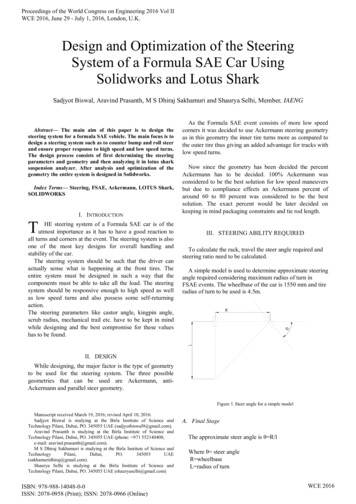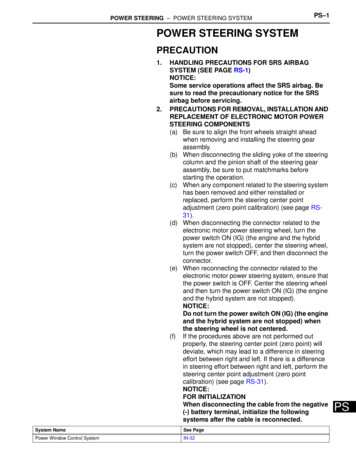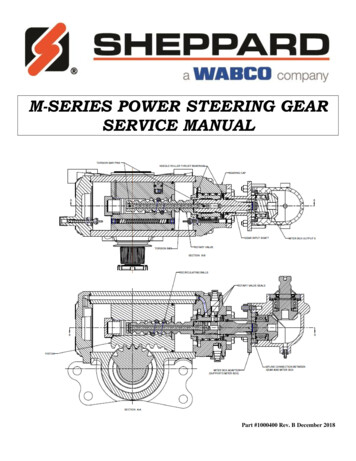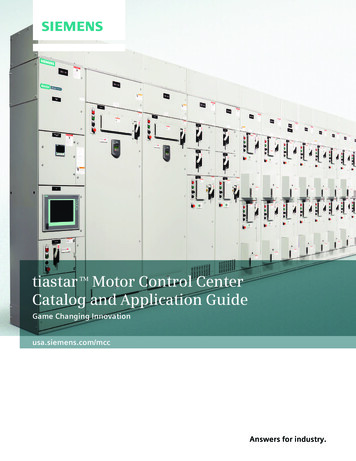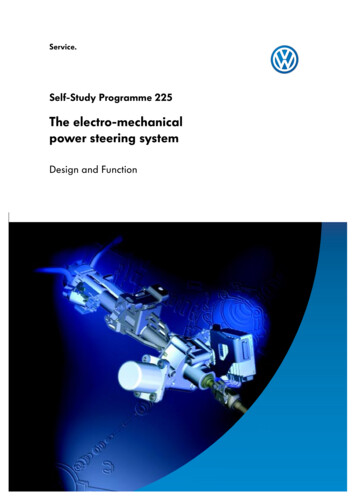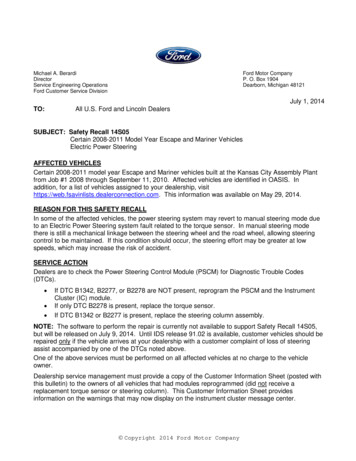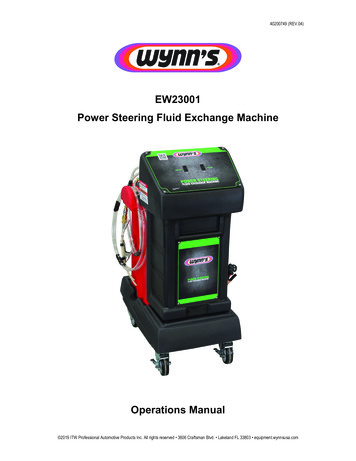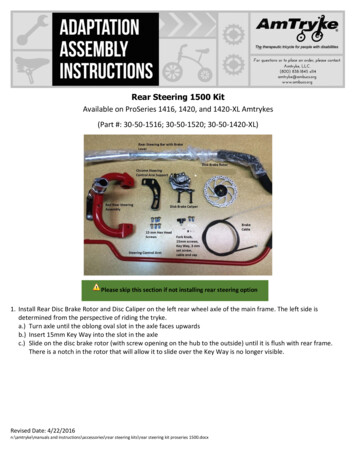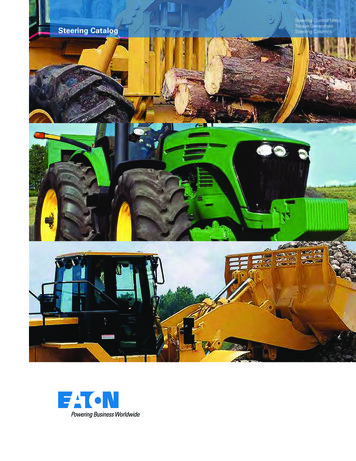
Transcription
Steering CatalogSteering Control UnitsTorque GeneratorsSteering Columns
Literature Referenced in this Catalog: Eaton Technical Bulletin 3-401 Eaton Flow Divider Catalog E-VLFL-MC001-E Eaton Relief Valve Catalog 11-510 Eaton Gear Pumps Series 26 Model 26000Catalog 11-609 Eaton Char-Lynn Low Speed High Torque MotorsCatalog E-MOLO-MC001-E2 Vickers Screw in Cartridge ValuesCatalog V-VLOV-MC001-E2 Vickers Proportional Valves Catalog 539 Vickers Solenoid Operated Directional ValvesCatalog GB-C-20152EATON Steering Catalog C-STOV-MC001-E3 November 2021
Description and AdvantagesSteering Control UnitsSERIES 5 (291-XXXX-XXX, 292-XXXX-XXX, 293-XXXX-XXX, 294-XXXX-XXX)The Char-Lynn steering control unit (SCU) is fully fluid linked.This means there is no mechanical connection between thesteering unit, the pump and the steering cylinders. The unitconsists of a manually operated directional control servovalve and feedback meter element in a single body. It is usedprincipally for fluid linked power steering systems but it canbe used for some servo-type applications or any applicationwhere visual positioning is required. The close coupled, rotaryaction valve performs all necessary fluid directing functionswith a small number of moving parts. The manually actuatedvalve is coupled with the mechanical drive to the meter gear.The control is lubricated and protected by the power fluid inthe system and can operate in many environments.DisplacementFlowPressureChar-Lynn power steering control units offer the followingadvantages:Displacement1230 - 3030 cm3/r75 - 185 in3/rFlowPressure151 - 227 l/min241 bar40 - 60 GPM3500 PSI Minimizes steering linkage—reduces cost, provides flexibility in design. Provides complete isolation of load forces from the control station—provides operator comfort. Provides continuous, unlimited control action with verylow input torque. Provides a wide selection of control circuits and metersizes. Can work with many kinds of power steering pumps orfluid supply.31.5 - 146 cm3/r11 - 19 l/min140 bar1.92 - 8.9 in3/r3 - 5 GPM2030 PSISERIES 25 (251-XXXX-XXX, 252-XXXX-XXX, 253-XXXX-XXX)DisplacementFlowPressure490 - 1230 cm3/r95 - 151 l/min241 bar30 - 75 in3/r25 - 40 GPM3500 PSISERIES 40 (281-XXXX-XXX, 282-XXXX-XXX, 283-XXXX-XXX)** For all other product numbers consult steering website.EATON Steering Catalog C-STOV-MC001-E3 November 20213
Description and AdvantagesTorque GeneratorSERIES 217, 227Char-Lynn torque generators have been completely redesigned to meet the needs of the changing marketplace.These torque generators have served the industry well,providing:DisplacementFlowPressure Power assist for vehicle steering Power assist on gates and valves, eliminating the largehand wheels Powerful rotary motion with effortless manual rotaryinput on numerous other applications76 - 160 cm3/r15 l/min69 and 172 bar4.7 - 9.6 in3/r4 GPM1000 and 2500 PSIToday’s market includes power steering on electric lift trucks.These new torque generators have been designed with features that greatly improve the operator’s comfort as well asthe vehicle’s performance.Use the Torque Generator as rotary power assist for: Large indexing tables Manually operated gates and valves Manual positioning devices Mechanical steering systems TurntablesCustomized Steering ColumnsChar-Lynn columns can be custom built to your exact specifications. The column and mounting flange is of a sturdy singleweldment design. These columns have high thrust and sideload capacity with low shaft torsional friction. A tilt column isalso available.4EATON Steering Catalog C-STOV-MC001-E3 November 2021STEERING COLUMNS (204-XXXX-XXX)Jacket LengthHorn WireUpper Ends56 - 836 mmwith and without10 Upper End Types2.2 - 33 inchwith and without10 Upper End Types
Hydraulic Circuit ExplanationNeutral Circuits: Open Center and Open CenterPower BeyondOpen Center Simplest, most economical system Uses a fixed displacement pump In neutral position pump and tank are connected Most suitable on smaller type vehiclesLRGerotorOpen Center Power BeyondThe power beyond steering control unit supplies steering andauxiliary valve functions. The power beyond unit is used onmedium pressure, open center (fixed displacement pump)systems. When not steering, the power beyond unit directsall inlet flow to the auxiliary circuit. However once steeringis initiated, part of the auxiliary flow is diverted to steering.Since steering has priority, all flow, if required, will be diverted to steering. The tank port of the steering unit has flowonly when steering is operated. Thus, flow out of the auxiliary(“PB”) port and the tank port will fluctuate or stop dependingon steering input.TPFixedDisplacementPumpThe following special considerations should be addressedwhen applying power beyond steering: Auxiliary valves (connected to PB) must be open centertype. Slight bump or kick may be felt in steering wheelwhen auxiliary functions are activated during steeringoperations. Pump flow not used for steering is available at powerbeyond (PB) outlet, except at steering stops where totalpump flow goes over the system relief valve. Avoid auxiliary functions that require constant flow while steering. Flow is only directed to the tank port when steering isoperated. Avoid systems where return flow from tankport is used for auxiliary functions. Inlet pressure to the steering unit will be the higher ofsteering system pressure or auxiliary valve pressure. Generally avoid systems where heavy use of auxiliaryfunctions occur while steering.Applications Lawn and Garden Equipment Utility VehiclesLRGerotorTPB PTo Auxilliary CircuitOpen Center ValvesFixedDisplacementPumpEATON Steering Catalog C-STOV-MC001-E3 November 20215
Hydraulic Circuit ExplanationNeutral Circuits: Closed CenterClosed Center Uses a pressure compensated variable displacementpump In neutral position pump and tank are disconnected Most suitable on large construction equipmentLRTPPressureCompensatedPumpValve Option AClosed Center SystemClosed Center with Neutral BleedNeutral Bleed FeatureClosed Center Steering Control Units are available with andwithout neutral bleed feature. Most applications may not require the bleed feature, however, the maximum temperaturedifferential between components within the steering circuitmust not exceed specification (50 F or 28 C). Order unitwith the bleed feature if the temperature differential may exceed this limit. The neutral bleed feature allows a small flowof fluid to pass through the unit when in neutral to reduce thethermal differential.Typical applications where neutral bleed is required are: Remote steering position from power source. Extended engine idle operation when vehicle is parked. High duty cycle operation sharing a common reservoirwith the steering circuit.Applications 6Construction IndustryEATON Steering Catalog C-STOV-MC001-E3 November kPwithNeutralBleedSteeringControlUnit
Hydraulic Circuit ExplanationNeutral Circuits: Load SensingLoad Sensing CircuitsChar-Lynn load sensing power steering uses conventional orload sensing power supplies to achieve load sensing steering.The use of a load sensing steering unit and a priority valve in anormal power steering circuit offers the following advantages: System Main Relief Valve—A pressure relief valve for theauxiliary circuit and/or a main safety valve for the protection ofthe pump is recommended and sized for the maximum pumpoutput flow rate. If a main relief valve is used, it must be setabove the priority circuit steering relief valve pressure setting.Provides smooth pressure compensated steering because load variations in the steering circuit do not affectaxle response or maximum steering rate.Steering CylinderProvides true power beyond system capability by splittingthe system into two independent circuits. Pressure transients are isolated in each circuit. Only the flow requiredby the steering maneuver goes to the steering circuit.Flow not required for steering is available for use in theauxiliary circuits.ManualInputListed below are the components of a typical load sensingcontrol circuit and a brief application description.RTPLSLoad SensingSteering UnitHigh PressureCarryoverCFLSProvides reliable operation because the steering circuitalways has flow and pressure priority.Char-Lynn load sensing steering control units and priorityvalves can be used with open center, closed center or loadsensing systems. Use in an open center system with a fixeddisplacement pump or a closed center system with a pressure compensated pump, offers many of the features of aload sensing system. Excess flow is available for auxiliarycircuitsLEFDSPPTMainReliefPPriority ValveDynamic SignalFilterPump—May be fixed displacement, pressure compensated,or flow and pressure compensated design.PumpPrime MoverPriority Valve—Sized for design pressure drop at maximumpump output flow rate and priority flow requirements. Theminimum control pressure must assure adequate steeringflow rate and must be matched with the steering control unit.A dynamic signal priority valve must be used with a dynamicsignal steering control unit.Steering Control Unit—Designed for specific rated flowsand control pressures. It must be matched with a controlpressure in the priority valve to obtain maximum steeringrates. Higher flow rates require higher control pressures. Neutral internal bleed assures component temperature equalization.LS Line—A LS line is always needed to sense pressuredownstream from the variable control orifice in the steeringcontrol unit. This is balanced by an internal passage to theopposite side of the priority control spool. The total systemperformance depends on careful consideration of the controlpressure chosen and pressure drop in the CF line.LS— Load SensingDS— Dynamic SignalPP— Pilot PressureCF— Control FlowEF— Excess FlowSteering Relief Valve—Must be factory set at least 10 bar[145 PSl] above the maximum steering cylinder pressurerequirement. Most of the flow will be directed to the auxiliarycircuit (EF) when the relief setting is exceeded.EATON Steering Catalog C-STOV-MC001-E3 November 20217
Hydraulic Circuit ExplanationNeutral Circuits: Load SensingLoad Sensing Circuits—Signal SystemsDynamic Signal—Open Center PumpTwo types of load sensing signal systems areavailable—Dynamic and Static.Dynamic Signal—Used for more difficult applications. Thedynamic signal systems offer the following benefits: Faster steering response. Improved cold weather start-up performance. Increased flexibility to solve problems related to systemperformance and nal)SteeringControl Unit(non-loadreaction)PLS CFEFTPHigh PressureCarryover toAuxiliary Circuit withOpen Center Valve(s)Priority Valve(Dynamic Signal)Fixed Displacement PumpLoad Sensing Steering System with FixedDisplacement Pump (Open Center Circuit)Dynamic Signal—Load Sensing PumpDynamicSignalLRTLSLS CFLoadSensing(DynamicSignal)SteeringControl Unit(non-loadreaction)PEFTShuttle ValvePAuxiliaryCircuit withLoad SensingValve(s)Priority Valve(Dynamic Signal)Pilot Signalfrom AuxiliaryCircuitPressure and FlowCompensated PumpLoad Sensing Steering System with Pressure and FlowCompensated Pump (Closed Center, Load Sensing Circuit)8EATON Steering Catalog C-STOV-MC001-E3 November 2021
Hydraulic Circuit ExplanationNeutral Circuits: Load SensingStatic Signal—Open Center PumpStatic Signal—Used for conventional applications whereresponse or circuit stability is not a problem. The load sensingpilot line should not exceed 2 meters [6 feet] in length.Static SignalLRTLSLS CFLoadSensing(StaticSignal)SteeringControl Unit(non-loadreaction)PAuxiliaryCircuit withOpen CenterValve(s)EFTPPriority Valve(Static Signal)Fixed Displacement PumpLoad Sensing Steering System withFixed Displacement Pump(Open Center Circuit)EATON Steering Catalog C-STOV-MC001-E3 November 20219
Hydraulic Circuit ExplanationWork Circuits: Non-Load Reaction and Load ReactionNon-Load ReactionA non-load reaction steering unit blocks the cylinder portsin neutral, holding the axle position whenever the operatorreleases the steering inkPSteeringControlUnitPressure and FlowCompensated PumpClosed Center SystemNon-Load Reaction CircuitLoad ReactionA load reaction steering unit couples the cylinder portsinternally (in the neutral position) with the meter gear set.Axle forces are then allowed to return the steering wheel toits approximate original position. Comparable to automobilesteering, gradually releasing the wheel mid turn will allow thesteering wheel to spin back as the vehicle straightens.The cylinder system used with load reaction units must haveequal oil volume displaced in both directions. The cylindersshould be a parallel pair (as shown) or one double rod endunit. Do not use with a single unequal area cylinder LinkPSteeringControlUnitFixedDisplacementPumpOpen Center SystemLoad Reaction Circuit10EATON Steering Catalog C-STOV-MC001-E3 November 2021
Steering Units with Integral ValvesIntegral valves are available for the Char-Lynn steering controlunit. Included are: Inlet Relief Valve, Cylinder Port ShockValves, LS-Relief Valve, and Anti-Cavitation Valves for cylinderports. In addition, a Manual Steering Check Valve for limitedmanual steering is included. The integral valves eliminate theneed for a separate valve block, and provides versatility tomeet any steering circuit standard.12Valve Description:1.Anti-cavitation check valve for cylinder ports—(R &L) protects steering circuit against vacuum (cavitation)conditions.2.Cylinder Port Relief Valves—(R & L) protects hosesagainst pressure surge created by ground forces on thesteered axle.3.Manual Steering Check Valve—converts unit to a handoperated pump for limited manual steering. Included in allunits except Series 25 and 40.**4.Inlet Relief Valve—limits maximum pressure dropacross the steering unit protecting the steering circuit.5.Inlet Check Valve—prevents oil from returning throughthe steering unit when pressure on the cylinder side isgreater than pressure on the inlet side to prevent steeringwheel kick.6.LS-Relief Valve—Limits maximum pressure in the steering circuit (LS units only)345EF**Steering units with displacements larger than 185 cm3/r [11.3 in3/r] mayrequire a separate power source for limited operation.6EATON Steering Catalog C-STOV-MC001-E3 November 202111
Special Features and ApplicationManual SteeringDescription30-60RPMThe steering control unit can provide steering flow when thepump or engine fails. It will pump oil through the meter (gerotor) as the operator applies input or torque to the steeringwheel which provides limited manual steering.[1000]This feature is available in all steering models except forSeries 25 and 40.[ 800]10-15RPM2.3.Determine steering work port pressure required topreform the desired steering maneuver from vehicle testdata. This defines the approximate manual steering pressure level required. Find this value on the vertical axis andconstruct a horizontal line on the graph.Find the input torque limit on the horizontal axis. Followhis vertically until it crosses the required pressure line ofstep 1.The maximum steering unit displacement is identified bythe first angled line to the left of this intersection.Displacementcm3/r [in3/r]7046[2.8]59[3.6]6096[5.9]74[4.5]Use of Graph1.1-3RPM120[7.3][ 600]50146[8.9]160[9.7][PSI]40bar185[11.3][ 400]230[14.1]295[17.9]370[22.6][ al Input TorqueNm [lb-ft]1) Maximum flow less than 7,6 l/min [2 GPM].2) Actual steering pressures required and manual steeringcapabilities must be verified with vehicle testingThe above curves are intended as a design guide only.12EATON Steering Catalog C-STOV-MC001-E3 November 2021
Eaton TechnologiesQ-Amp (Flow Amplification) for Load Sensing CircuitsDescriptionConventional Steering Control UnitQ-Amp steering units have built in variable orifices thatprovide flow directly to the cylinder without going throughthe gerotor section. The orifices do not open until after thegerotor begins to rotate and then gradually open until the desired flow is achieved which is proportional to the flow goingthrough the gerotor. A typical Q-Amp unit has a ratio of 1.6 :1 which means the flow of the cylinder is 1.6 times the flowgoing through the gerotor when turning the steering wheel atmedium to fast speeds. (See model code for available es Variable Ratio2:1Q-Amp Steering Control Unit—Fast Turn1.6:1RatioFastTurn1:1RotaryValveMeter10 20 30 40 50 60 70 80 90 100RPM65Turns 4Lock 3to2Lock 1Q-Amp Steering Control Unit—Slow Turn10 20 30 40 50 60 70 80 90 100RPM CylinderPumpManual SteeringSteering a vehicle with loss of engine power may notbe possible with a large displacement steering controlunit (SCU). Q-Amp with manual feature has the smallerdisplacement required for manual steering and has theadditional flow requirement of the larger displacementSCU for power steering.No FlowSlowTurnRotaryValveMeterPumpCylinderSingle Cylinder (Unequal area)On vehicles with one single unequal area cylinder thesteering wheel turns lock to lock are more in one direction than the other. When extending the rod one wouldget more turns than when retracting it. A different Q-Ampratio while turning in one direction versus the other canbe used to give an equal number of turns lock to lock ineach direction.EATON Steering Catalog C-STOV-MC001-E3 November 202113
Eaton TechnologiesQ-Amp (Flow Amplification) for Load Sensing CircuitsApplicationsVariable RatioArticulated vehicles such as wheel loaders, log skidders,scrapers, trucks, and similar vehicles can benefit from thisfeature. Wheel Loaders Scrapers Articulated AG Tractors Articulated Dumpers Mine Trucks Forestry Equipment Rough Terrain Lift TrucksWhile roading, a slow movement of the steering wheel (inputspeed), will not overcorrect steering. Increasing input speedwill produce the additional steering flow required to quicklychange the vehicle’s direction.For example, operating log skidders in the woods requiresvery quick steering. This same log skidder on the road wouldbe extremely difficult to steer a straight normal course. Thevariable ratio feature provides good steering in both conditions.Combines, row crop tractors, and large articulated agriculturaltractors also can benefit from this feature when travelingdown a field. It will be easier to follow rows or furrows, andstill be able to make fast turns at the end of the rows.14EATON Steering Catalog C-STOV-MC001-E3 November 2021Variable Ratio with Manual Steering AG Tractors Small Wheel Loaders Rubber Tired Excavators Sprayers Site Handlers Graders Combines
Eaton TechnologiesWide AngleDescriptionBenefits Minimizes jerking motion on medium and large articulated vehicles. Jerk reducing valves and accumulators can be eliminatedon most vehicles. Available on Series 25. Eliminates need for cushion valvesApplications 125 msdardFlowStanSteering units with wide angle features have been developed to significantly reduce or eliminate the jerky motion ofvehicles with articulated steering systems. This has beenaccomplished by increasing the maximum deflection of thespool relative to the sleeve. Increasing the deflection reducesthe gain. This in turn reduces acceleration and jerk levels andprovides overall smoother vehicle performance. The steeringstill responds fast enough so the operator does not notice thereduced gain.60 RPMideWgleAnTimeComputer SimulationSteering Input (RPM)60 RPM CWJerk (g/sec)Jerk (g/sec)840-460 RPM CCW-8Articulated Vehicles01234Time (Seconds)Standard Steering on a 25 Ton Loader6Jerk (g/sec)Steering Input (RPM)60 RPM CWJerk (g/sec)840-460 RPM CCW-8012346Time (Seconds)Wide Angle Steering on a 25 Ton LoaderThese graphs show a computer simulation of the jerk levels and have beenverified by actual vehicle tests.EATON Steering Catalog C-STOV-MC001-E3 November 202115
Eaton TechnologiesCylinder DampingDescriptionFlow Amplification without Cylinder DampingCylinder damping can help smooth the steering action of largearticulated vehicles such as loaders, scrapers, and skidders.These vehicles have overhanging weight with high inertialloads. This energy is dissipated by the cylinder dampingorifices which bleed a small amount of flow from the cylinderport to tank.Cylinder Damping has 3 different levels of application. Thenumber of levels equal to the number of Cylinder Damping(CD) orifices. This technology is available on Series 25 andSeries 40. Not all SCUs come with all 3 levels.Flow Amplification with Cylinder DampingFeatures1.Level 1: for slightly jerky vehicle (lower flow rates for thesteering unit)2.Level 2: for jerky vehicle3.Level 3: for severely jerky vehicle (higher flow rates forthe steering unit)Benefits Reduces jerking motion on medium and large articulatedvehicles. Available on the following steering control units (Series25, 40). Damps or stabilizes unstable systems.Applications—Large Articulated Vehicles Wheel Loaders Skidders Scrapers16EATON Steering Catalog C-STOV-MC001-E3 November 2021
Eaton TechnologiesSTC Direct PortingWith the Snap-To-Connect (STC) Direct Porting option, thefitting profile is machined into the SCU housing, eliminatingthe need for extra STC fittings. This revolutionary and porting technology provides leak-proof sealing and has operatingpressure capability exceeding 4500PSI (310bar).BenefitsSTC Direct Porting is available with Series 5 Steering ControlUnits. STC Direct Ports provide a great opportunity for significant cost savings compared to threaded fittings Eliminates the need for assembly tools during installation Eliminates installation variability Improves ergonomics - reduces installer effort to connect Improves serviceability High quality, leak-proof seal Eliminates connector leakage Compact design and overall lighter weightEATON Steering Catalog C-STOV-MC001-E3 November 202117
Steering Control Units—Series 5Product DescriptionThe new Series 5 steering control units (SCU) are excitingnew products designed for low flow, low pressure applications. The Series 5 units are available in two compact designs:Option 1:Square Housing (Mount) Unit with Side PortsOption 2:Round Housing (Mount) Unit with End PortsIn addition to the installation flexibility provided by the twooptions above, this new family of products has best in-classsteering feel and provides crisp centering. These units alsohave better efficiency (lower pressure drop) than competitiveunits.Power Beyond Models—Optional power beyond steeringcontrol units supply steering and flow to auxiliary valve functions. The power beyond unit is used in open center (fixeddisplacement pump) systems in the medium pressure range.When not steering, the power beyond unit directs all inletflow to the excess flow port (power beyond) for use in theauxiliary circuit. Once steering is initiated, and since steeringhas priority, inlet flow will be diverted to the steering circuitas required. Flow out the excess flow port (power beyond)and tank port will vary or stop depending upon the steeringrequirement. The tank port of the steering unit has flow onlywhen steering is operating.Features Open Center Load Sensing Open Center Power BeyondIntegral Column Manual SteeringCheck Valve Inlet Relief Valve Load Sense Relief Valve Cylinder Relief Valve Anti-Cavitation ValveApplications Lawn and Garden Equipment Turf Equipment Golf CourseMaintenanceEquipment Lift Trucks Compact Utility Tractors18EATON Steering Catalog C-STOV-MC001-E3 November 2021Option 1: Square Housingwith Side Portsrefer to Model Code, page 26Option 2: Round Housingwith End Portsrefer to Model Code, page 27SPECIFICATIONSMax. System PressureMax. Back PressureMax. FlowMax. DifferentialBetween Steering Unitand System TemperatureMax. System OperatingTemperatureInput TorquePowered -StandardLowMax. Non PoweredFluidRecommended FiltrationPort OptionsCheck Valve forManual SteeringOptional Relief ValveSettings bar[PSI]140 bar [2030 PSI]21 bar [ 300 PSI]19 l/min [5 GPM]28 C50 F93 C [200 F]1,7 - 2,8 Nm @ 6,9 bar tank pressure[15 - 25 lb-in @ 100 PSI tank pressure]1,1 - 2,0 Nm @ 6,9 bar tank pressure[10 - 17.5 lb-in @ 100 PSI tank pressure]81,4 Nm [60 lb-ft]Petroleum Based FluidsISO 18/13 cleanliness level9/16-18 SAE O-ring– 06 STC3/8 BSP Straight thread portsYes40 [ 580]50 [ 725]63 [ 914]70 [1015]80 [1160]90 [1305]100 [1450]125 [1812]
Steering Control Units—Series 5Model Code – Ordering InformationSquare Housing with Side Ports - Option 1The following 30-digit coding system has been developed toidentify all of the configuration options for the Series 5 steering control units. Use this model code to specify a unit withthe desired features. All 30-digits of the code must be present when ordering. You may want to photocopy the matrixbelow to ensure that each number is entered in the correctbox.123A B RNos1,2,34Feature4567C A8910 11 12 13 14 15 16 17 18 19 20 21 22 23 24 25 26 27 28 29 300CodeProduct SeriesABRNominal Flow1RatingB5Inlet PressureCRating6Tank PressureARatingB7-8Displacement353739414346489Flow Amplification010Neutral CircuitABF11Load CircuitA12,13Valve Options010405121314,15Integral Inlet00Relief Valve18Setting1J1Z262G2T343W16,17Cylinder Relief00Setting37425568AA 0Code0BDescriptionNosSeries 5 Steering Control Unit11 l/min [3 GPM]19 l/min [5 GPM]140 bar [2030 PSI]18,19,20, Ports and4AAN Square 4 x 9/16 SAE Ports,Mounting ThreadsM10 x 1,5 Column MountingThreads (Use with Open Center)4AKN Square 5 x 9/16 SAE Ports,M10 x 1,5 Column MountingThreads (Use with Excess Flow)4AEN Square 5 x 9/16 SAE Ports,M10 x 1,5 Column MountingThreads (Use with Load Sense)UAAN Square 4 x -06 STC Direct Ports,M10 x 1,5 Column MountingThreads (Use with Open Center)UBNN Square 5 x -06 STC Direct Ports,M10 x 1,5 Column MountingThreads (Use with Excess Flow)UBPN Square 5 x -06 STC Direct Ports,M10 x 1,5 Column MountingThreads (Use with Load Sense)YAAN Square 4 x G .375 BSP StraightThd. Ports, M10 x 1,5 ColumnMounting Threads(Use with Open Center)YBRN Square 5 x G .375 BSP StriaghtThd. Ports, M10 x 1,5 ColumnMounting Threads(Use with Load Sense)22Input Torque1Low*3Standard23Fluid TypeASee Eaton TechnicalBulletin 3-40124Special Application 0None25,26Special FeatureAANone27Paint1Black Primer28Identification0Eaton Product Number onNameplate29MechanicalATapered 17.919mm (.7055in)Interfacediameter, .083:1 and serrated17.5 (.688) diameter, 40 tooth,M16x1.5-6g, Extension length65.02 (2.56)DInternal involute spline12 tooth,16/32 DP, 30 degree PA30Eaton AssignedBAssigned Design CodeDesign Code10 bar [150 PSI]21 bar [300 PSI]31.5 cm3/r [1.92 in3/r]39.5 cm3/r [2.41 in3/r]50.8 cm3/r [3.10 in3/r]63.1 cm3/r [3.85 in3/r]73.8 cm3/r [4.50 in3/r]100 cm3/r [6.10 in3/r]120 cm3/r [7.33 in3/r]NoneOpen CenterOpen Center, Power BeyondLoad Sensing, Dynamic signalNon-Load ReactionManual Steering Check ValveInlet Check Valve, ManualSteering Check ValveInlet Relief Valve,Manual Steering Check ValveCylinder Relief Valve,Anti-Cavitation Valve,Inlet Relief Valve,Inlet Check Valve,Manual Steering Check Valve.Cylinder Relief Valve,Anti-cavitation Valve, Inlet CheckValve, Load Sensing Relief Valve,Manual Steering Check ValveNone40 bar [580 PSI]50 bar [725 PSI]63 bar [914 PSI]70 bar [1015 PSI]80 bar [1160 PSI]90 bar [1305 PSI]100 bar [1450 PSI]125 bar [1812 PSI]None103 bar [1490 PSI]130 bar [1890 PSI]185 bar [2680 PSI]200 bar [2900 PSI]Feature1Description* All low torque units need approval from an Eaton Steering Engineer.EATON Steering Catalog C-STOV-MC001-E3 November 202119
Steering Control Units—Series 5Model Code – Ordering InformationRound Housing with End Ports - Option 2The following 30-digit coding system has been developed toidentify all of the configuration options for the Series 5 steering control units. Use this model code to specify a unit withthe desired features. All 30-digits of the code must be present when ordering. You may want to photocopy the matrixbelow to ensure that each number is entered in the correctbox.123A B RNos1,2,34Feature4567ACodeProduct SeriesABRNominal Flow1RatingB5Inlet PressureRatingC6Tank PressureARating7-8Displacement353739414346489Flow Amplification010Neutral CircuitABCF11Load CircuitA12,13Valve Options0104051214,15Integral Inlet00Relief Valve18Setting1J1Z262G2T343W4C16,17Cylinder Relief00Setting208910 11 12 13 14 15 16 17 18 19 20 21 22 23 24 25 26 27 28 29 300A00A 0BNosSeries 5 Steering Control Unit11 l/min [3 GPM]19 l/min [5 GPM]18,19,Ports andVAAH Round 4 x 9/16 SAE20, 21Mounting ThreadsPorts, M6 x 1,0 ColumnMounting Threads(Use with Open Center)VAKH Round 5 x 9/16 SAE Ports,M6 x 1,0 Column MountingThreads (Use with Excess Flow)VAEH Round 5 x 9/16 SAE Ports,M6 x 1,0 Column MountingWAAH Round 4 x -06 STC Direct Ports,M6 x 1,0 Column MountingThreads (Use with Open Center)WBNH Round 5 x -06 STC Direct Ports,M6 x 1,0 Column MountingThreads (Use with Excess Flow)WBPH Round 5 x -06 STC Direct Ports,M6 x 1,0 Column MountingThreads (Use with Load Sense)22Input Torque1Low*3Standard23Fluid TypeASee Eaton TechnicalBulletin 3-40124Special Application 0None25,26Special FeatureAANone27Paint1Black Primer28Identification0Eaton Product Number onNameplate29MechanicalATapered 17.919mm (.7055in)Interfacediameter, .083:1 and serrated17.5 (.688) diameter, 40 tooth,M16x1.5-6g, Extension length65.02 (2.56)DInternal involute spline12 tooth,16/32 DP, 30 degree PA30Eaton AssignedBAssigned Design CodeDesign Code31.5 cm3/r [1.92 in3/r]39.5 cm3/r [2.41 in3/r]50.8 cm3/r [3.10 in3/r]63.1 cm3/r [3.85 in3/r]73.8 cm3/r [4.50 in3/r]100 cm3/r [6.10 in3/r]120 cm3/r [7.33 in3/r]NoneOpen CenterOpen Center, Power BeyondClosed CenterLoad Sensing, Dynamic signalNon-Load ReactionManual Steering Check ValveInlet Check Valve, ManualSteering Check ValveInlet Relief Valve,Manual Steering C
Manual positioning devices Mechanical steering systems Turntables Customized Steering Columns Char-Lynn columns can be custom built to your exact specifi-cations. The column and mounting flange is of a sturdy single weldment design. These columns have high thrust and side load capacity with low shaft torsional friction. A tilt column is
